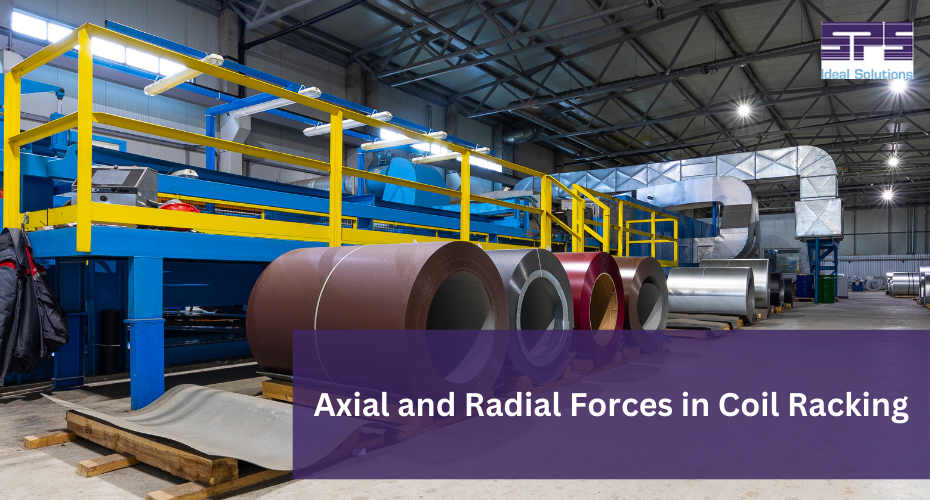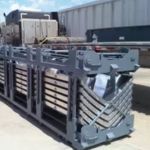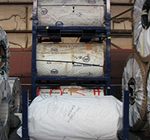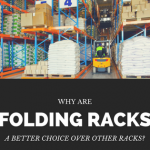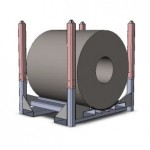Engineering Considerations for Axial and Radial Forces in Coil Racking
Metal coil storage presents unique engineering challenges that demand careful consideration of force distribution and structural integrity. As industrial operations increasingly rely on efficient coil handling systems, understanding the complex interplay between axial and radial forces becomes critical for safe, cost-effective storage solutions.
Understanding Force Distribution in Coil Storage Systems
Metal coils, whether steel, aluminium or copper generate substantial forces when stored in racking systems. These forces manifest in two primary directions: axial forces that act parallel to the coil’s central axis and radial forces that push outward from the center of the coil toward its circumference.
Looking for expertly engineered coil storage solutions? Explore SPS Ideal Solutions comprehensive coil rack systems designed to handle complex force distributions safely and efficiently.
The weight of a typical steel coil can range from several hundred pounds to over 40 tons, creating concentrated load points that traditional storage systems struggle to accommodate. When multiple coils are stacked or stored adjacently, these forces compound, creating complex loading scenarios that require sophisticated engineering analysis.
Axial forces primarily result from the coil’s weight distribution along its length, while radial forces emerge from the coil’s tendency to expand outward under its own weight. The interaction between these forces varies significantly based on coil dimensions, material properties, and storage orientation.
Critical Design Parameters for Coil Racking Systems
Successful coil racking design begins with accurate load calculations that account for both static and dynamic forces. Engineers must consider the maximum coil weight, dimensional variations, and potential impact loads during placement and removal operations.
The structural framework must distribute concentrated coil loads across multiple support points while maintaining adequate safety factors. This typically involves using robust steel construction with reinforced connection details at critical load transfer points. The spacing and configuration of support cradles directly influence how forces are transmitted through the structure.
Material selection plays a crucial role in system performance. High-strength structural steel grades provide the necessary load-carrying capacity while minimizing deflection under heavy loads. Connection details, including bolted and welded joints, must be designed to resist both tension and compression forces generated by coil storage.
Proper foundation design ensures that concentrated loads from the racking system are adequately distributed to the supporting soil or concrete slab. This often requires spread footings or reinforced concrete pads capable of handling point loads without excessive settlement.
Managing Radial Force Challenges
Radial forces present particular challenges because they can cause coils to deform or spread, potentially compromising both the stored material and the racking structure. Effective containment systems must balance the need to restrict radial expansion while allowing for thermal movement and material variations.
Cradle design significantly impacts radial force management. V-shaped cradles provide natural containment by redirecting radial forces into the supporting structure, while flat supports may allow excessive spreading. The cradle angle and contact area must be optimized to minimize stress concentrations while providing stable support.
Side containment systems, including adjustable barriers or guides, help control radial expansion without creating rigid constraints that could damage the coil during thermal cycling. These systems must accommodate dimensional tolerances while preventing coil movement during handling operations.
Addressing Axial Load Distribution
Axial forces require careful consideration of support point spacing and load distribution along the coil length. Insufficient support can lead to coil sagging or permanent deformation, while excessive support points may create unnecessary stress concentrations.
The number and positioning of support cradles depend on coil dimensions, material properties, and allowable deflection limits. Longer coils typically require additional intermediate supports to prevent excessive bending moments, while shorter coils may be adequately supported with end cradles alone.
Support point design must account for varying coil lengths within the same storage system. Adjustable or modular cradle systems provide flexibility to accommodate different coil sizes while maintaining proper load distribution. This adaptability proves essential in facilities handling diverse product ranges.
Safety Factors and Structural Reliability
Coil racking systems operate in demanding industrial environments where safety cannot be compromised. Appropriate safety factors must account for dynamic loading, material variations, and potential impact forces during coil handling operations.
Standard practice requires minimum safety factors of 2.0 to 3.0 for static loads, with higher factors applied to account for dynamic effects and uncertainty in loading conditions. These factors ensure adequate structural margin even under adverse conditions or unexpected load combinations.
Regular inspection and maintenance protocols help identify potential issues before they compromise system integrity. This includes monitoring for signs of excessive deflection, connection looseness, or material degradation that could affect load-carrying capacity.
Advanced Analysis Techniques
Modern coil racking design benefits from sophisticated analysis methods including finite element modelling and dynamic load simulation. These tools enable engineers to optimize structural configurations while minimizing material usage and cost.
Computer modelling allows detailed investigation of stress distributions, deflection patterns, and failure modes under various loading scenarios. This analysis capability proves particularly valuable for custom applications or unusually large coil storage requirements.
Dynamic analysis helps predict system response to handling operations, seismic events, or other transient loading conditions. Understanding these effects enables designers to incorporate appropriate damping or isolation measures where necessary.
Economic Considerations and Optimization
Efficient coil racking design balances structural performance with economic constraints. Optimizing material usage while maintaining safety requirements directly impacts project viability and long-term operational costs.
Standardization of components and connection details reduces fabrication costs and simplifies maintenance procedures. Modular design approaches enable system expansion or reconfiguration as operational requirements change.
Life-cycle cost analysis should consider not only initial construction costs but also maintenance requirements, operational efficiency, and potential expansion needs. Well-designed systems often justify higher initial investment through reduced maintenance and improved operational flexibility.
Ready to optimize your coil storage costs and efficiency? Contact SPS Ideal Solutions to discuss custom coil racking solutions tailored to your specific operational requirements.
Conclusion
Engineering considerations for axial and radial forces in coil racking demand comprehensive understanding of structural mechanics, material behavior, and operational requirements. Successful systems integrate robust structural design with practical considerations for handling, maintenance, and operational flexibility. Through careful attention to force distribution, structural optimization, and safety factors, engineers can deliver storage solutions that provide reliable service while minimizing operational risks and costs. The complexity of modern coil storage applications requires collaboration between structural engineers, material handling specialists, and operational personnel to achieve optimal results.
Transform your coil storage operations with professionally engineered solutions. Request a detailed quote from SPS Ideal Solutions and discover how optimized coil racking can enhance your facility’s safety, efficiency, and productivity.
About The Author

